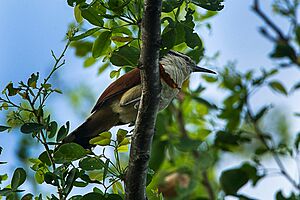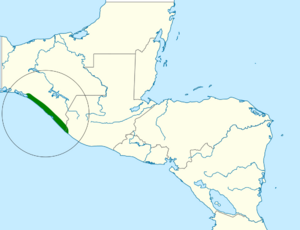Giant wren facts for kids
Quick facts for kids Giant wren |
|
|---|---|
 |
|
| Conservation status | |
| Scientific classification | |
| Genus: |
Campylorhynchus
|
| Species: |
chiapensis
|
 |
|
The giant wren (Campylorhynchus chiapensis) is a type of bird that belongs to the wren family. It's known for being the biggest wren in the world! You can find this special bird living in parts of Mexico and Guatemala.
Contents
About the Giant Wren
The giant wren is a unique bird because it's the only one of its kind (scientists call this monotypic). This means there are no different subspecies of the giant wren. Even though some giant wrens in the northern areas are a bit bigger, they are not different enough to be called separate types. Some scientists think it might be closely related to another bird called the bicolored wren.
What Does the Giant Wren Look Like?
As its name suggests, the giant wren is the largest bird in the wren family. It grows to be about 20 to 22 cm (7.9 to 8.7 in) long. It weighs around 43.4 to 57 g (1.53 to 2.01 oz), which is about the weight of a few strawberries! Both male and female giant wrens look very similar.
- Head and Neck: They have a black top of the head, back of the neck, and shoulders. A white stripe, called a supercilium, goes above their eye. This white stripe separates the black on their head from a black stripe that goes through their eye. The rest of their face is also white.
- Body: Their upper body is a bright chestnut color. Their tail is a darker chestnut. Almost all of their tail feathers have a white band near the end.
- Underparts: From their chin all the way to their belly, their underside is white. The very bottom part of their belly is a buff (light brownish-yellow) color.
- Young Birds: Baby giant wrens look a lot like the adults, but their undersides are more whitish instead of pure white.
Where the Giant Wren Lives
The giant wren was once thought to live only in the Chiapas state of Mexico. This area stretches from Puerto Arista south towards the border with Guatemala. However, since about 2010, many giant wrens have been seen in the far northwestern part of Guatemala too!
This bird likes to live in bushy areas. It can even be found in places that humans have changed a lot, like farmyards, hedgerows (rows of bushes that form a fence), and fruit orchards. It only lives within 50 km (31 mi) of the coast. You can find them from sea level up to about 300 m (980 ft) high.
Giant Wren Behavior
What the Giant Wren Eats
Scientists haven't fully studied what the giant wren eats, but they believe it mostly eats small creatures without backbones, like insects. It usually looks for its food on the ground or very close to it.
Reproduction and Life Cycle
The giant wren's breeding season is from May through July. It's possible that they raise two sets of babies in one season. There's also some evidence that other wrens might help the parents take care of the nest.
- Nest: The nest is shaped like a big ball with an opening on the side. It's made from straw and other rough plant fibers. They often build their nests in acacia trees.
- Eggs: So far, only one nest has been recorded with eggs, and it had three eggs.
Giant Wren Sounds
Giant wren pairs often sing together! Their songs are described as "rhythmic hollow phrases, chortling and rollicking" [1]. They also make calls that sound "grating and harsh churring" [2].
Conservation Status
The IUCN (International Union for Conservation of Nature) has looked at the giant wren's situation. They have assessed it as being of "Least Concern." This means that the giant wren is not currently in danger of disappearing. Its population seems to be more than 20,000 birds, and it is thought to be stable. There's no evidence that its numbers are going down or that it faces any major threats.


